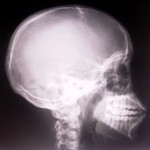TMJ Pain and Arthritis
by Jennifer Bunn, RNThe temperomandibular joint is not a joint that is commonly affected by arthritis, but when it is it can cause considerable pain and dysfunction. Talking, swallowing and chewing can become very painful activities, and because it is almost impossible to rest this joint, pain may be unrelenting.
 The TMJ is the joint that joins the mandible (lower jaw) to the skull, so pain in this area can also cause pain in the ear. People who experience TMJ pain often believe that the source of their pain is their teeth. If someone is already known to have arthritis, the problem is generally easier to diagnose.
The TMJ is the joint that joins the mandible (lower jaw) to the skull, so pain in this area can also cause pain in the ear. People who experience TMJ pain often believe that the source of their pain is their teeth. If someone is already known to have arthritis, the problem is generally easier to diagnose.
Pain can often be relieved with pain medication and heat, which may relax the joint. When these remedies fail, doctors may opt to perform arthrocentesis, flushing the joint with anesthetic and sterile fluids to rid the joint of any fluids that result from inflammation. They may instill steroids to counter any further inflammation. If this procedure is unsuccessful, surgeons may opt to perform arthroplasty, sometimes replacing the joint completely. Although arthroplasty is generally successful, it is not without risk, and less invasive measures should be attempted first.
TMJ pain can cause considerable pain and distress to the person who experiences it. Early diagnosis and treatment can result in improved function of the joint and relief of pain.
PreArthros is a twice-daily botanical formulation designed to ease arthritis pain naturally, with no side effects.
Source: TMJ Disease
